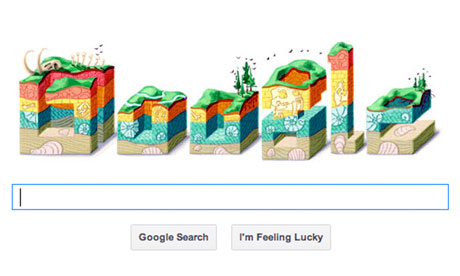Remembering One of the “Fathers of Modern Geology”
Google has commemorated the date regarded by many academics as the birthday of one of the “fathers of modern geology” Nicolas Steno by creating a stratigraphic “google doodle” which is being displayed as the main icon on the google home page. It may have been the likes of Charles Darwin and Georges-Louis de Buffon that are better known when it comes to Europeans that have influenced the nascent sciences of palaeontology and geology but the contribution made by this Danish academic and member of the Catholic church in the 17th century cannot be underestimated.
Nicolaus Steno, referred to in Denmark as Niels Stensen, was born 374 years ago today (based on accepted data regarding his actual date of birth). He lived by the principle that a person should try to investigate the world around them and not simply accept what was written down by others. His, at the time, controversial views were to lead to disagreements and conflict amongst other scientists and the church. The conclusions made by Stenos in the course of his life were to challenge the accepted religious doctrine.
Nicolas Steno
Born in Copenhagen (Denmark) in 1638, as a young man he had the opportunity to travel widely throughout Europe. His inquiring mind and meticulous observations led him to investigate a very broad range of scientific subjects. For example, he studied human anatomy and helped to improve medical knowledge. However, he is perhaps best remembered for his written texts on how layers of sedimentary rock are formed. He openly challenged the established religious doctrine regarding how old the Earth was and how it was formed. His published work helped to lay the foundation for the modern science of geology and he is often referred to as “one of the founders of modern geology”.
The Google Doodle – Celebrating the Birth of Nicolas Steno
Picture credit: Google
Layers of Rock
The clever doodle is split into the six google letters with each letter being made up of layers of rock. The different colours of the layers and the fossils in them hint at one of the main tenets of the work of Steno, that layers are laid down in sequence and bizarre objects found in some of these layers such as “tongue stones” are actually the remains of long-dead animals that have been turned to stone (fossilised).
Other scientists in the 17th century, thought that these strange objects we now identify as fossils, simply grew in rock formations. Nicolaus Steno was not the first academic to consider fossil material but he made an invaluable contribution to the foundation of geology and established a fundamental principle of stratigraphy (study of rock layers) – that in most cases younger rocks can be found on top of older rocks.
Younger rocks on top of older rocks is the abiding principle of the Law of Superposition, it was Nicolaus Steno who first formulated this law of geology and it is great to see google remembering this important European scientist.
To purchase highly-accurate models of iconic animals from the fossil record like ammonites and trilobites: Toys and Models to Help Learn About Prehistoric Life.






Leave A Comment